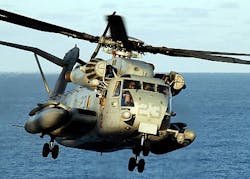Raytheon to provide midwave infrared sensor turrets for CH-53K and HH-60 military helicopters
PATUXENT RIVER NAS, Md., 2 Oct. 2013. U.S. Navy helicopter avionics experts needed forward-looking infrared (FLIR) sensor pods for CH-53K heavy-lift helicopters and for HH-60 special operations helicopter. They found their solution from the Raytheon Co. Space and Airborne Systems segment in El Segundo, Calif.
Officials of the Naval Air Systems Command (NAVAIR) at Patuxent River Naval Air Station, Md., awarded $20 million order to Raytheon late last week to provide 30 AN/AAQ-29A electro-optical FLIR kits -- five for the CH-53 and 35 for the HH-60.
The AN/AAQ-29A is a lightweight, high performance FLIR with a 480-by-640-pixel 3-5 micron wavelength indium antimonide midwave infrared detector and a three-field-of-view telescope on a 12-inch turret. The FLIR pod helps helicopter pilots with low-level navigation to high altitude long-range targeting.
The Sikorsky CH-53K Super Stallion is a large, heavy-lift cargo helicopter for the U.S. Marine Corps. The three-engine rotorcraft has composite rotor blades, wide cabin, and will be the largest and heaviest helicopter in the U.S. military when it enters service sometime next year.
The Sikorsky HH-60 is a multi-mission, twin-engine, medium-range helicopter for search and rescue. It is based on the Navy SH-60 Seahawk helicopter. The HH-60 can fly a crew of four as far as 300 miles, hoist as many as six additional people on board while remaining on-scene for as long as 45 minutes, and return to base while maintaining a fuel reserve.
The Raytheon AN/AAQ-29A FLIR can support helicopter surveillance, navigation (even at low level) and long-range target acquisition using midwave infrared sensor technology. The sensor enables helicopter pilots to see through darkness, smoke, haze, and bad weather.
The contract to Raytheon includes 25 L2G multifunction control units and 35 L2G system control units for the HH-60 helicopters; two memory loader verifier system cables and software update, system integration and test support for the CH-53K helicopters; one technical data package; and repair of repairables analysis.
Raytheon will do the work in McKinney, Texas, and El Segundo, Calif., and should be finished by September 2015. For more information contact Raytheon Space and Airborne Systems online at www.raytheon.com/capabilities/global_isr, or Naval Air Systems Command at www.navair.navy.mil.
